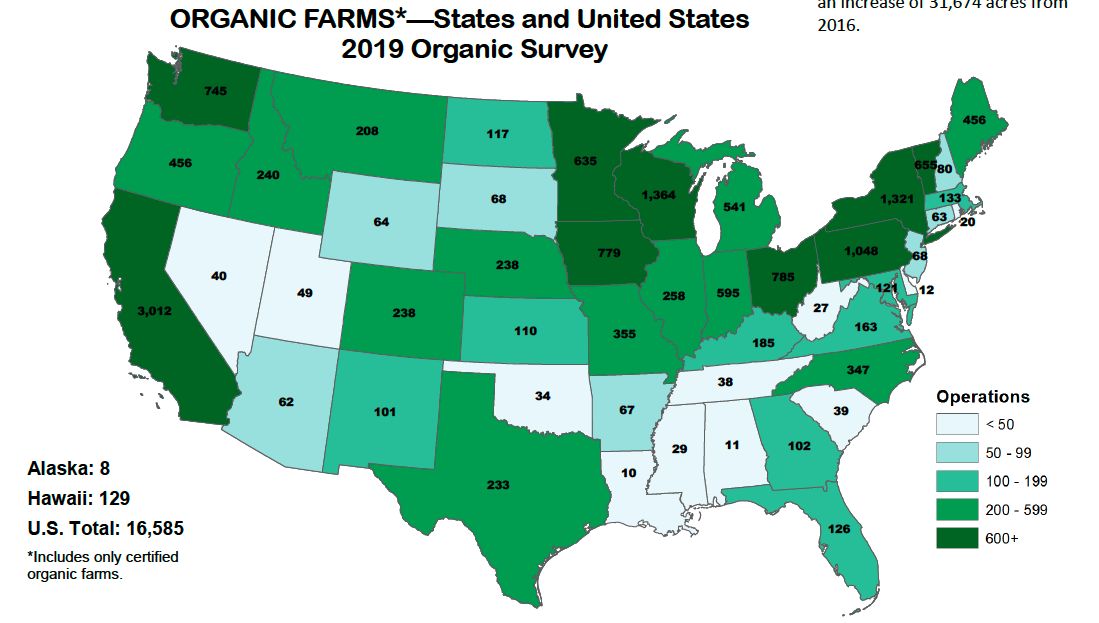
Oct 22, 2020
Organics sales up, farmers plan production growth: USDA survey
The USDA on Oct. 22 released the results of the 2019 Organic Survey, which show large growth in production and sales over the last three years.
Sales of organic products reached $9.93 billion in 2019, an increase of $2.37 billion, or 31%, from 2016, according to the USDA’s National Agricultural Statistics Service (NASS). The survey counted 16,585 certified organic farms – a 17% increase from 2016 – which accounted for 5.50 million certified acres, 9% more acres than in 2016.
California continued to lead the nation in certified organic with $3.60 billion, which is 36% of the U.S. total and four times that of any other state. It also led all states with 3,012 certified farms and 965,257 certified acres. Washington ($886 million), Pennsylvania ($742 million), Oregon ($454 million), and Texas ($424 million), round out the top five states for value of organic sales.
“The results of the 2019 Organic Survey show the continued growth of organic production in the United States,” NASS Administrator Hubert Hamer said in a news release.
The Organic Trade Association (OTA) in a released statement thanked the USDA for the survey, “but the numbers show that organic acreage is still less than 1% of our total farmland.”
“This points to a real need for more technical, risk management and financial support for farmers wanting to transition to organic,” OTA said in its statement. “USDA’s data bears out the continued – and urgent — need for greater support from the government to allow organic to continue its advancement.”
The top sectors and commodities in 2019 were:
- Livestock and poultry products: $2.48 billion, up 12% – Milk: $1.59 billion, up 14%.
- Vegetables: $2.08 billion, up 27% – Lettuce: $400 million, up 44%.
- Fruits, tree nuts, and berries: $2.02 billion, up 44% – Apples: $475 million, up 45%.
- Livestock and Poultry: $1.66 billion, up 44% – Broiler chickens: $1.12 billion, up 49%.
- Field Crops: $1.18 billion, up 55% – Corn for grain: $278 million, up 70%.
Other top organic commodities with the greatest gains in value of sales from 2016 were spinach (52%), grapes (52%), cultivated blueberries (104%), raspberries (197%), and turkeys (68%).
Marketing practices in the certified organic farming sector showed that $2.04 billion in organic products were sold directly to retail markets, institutions, and local/regional food hubs. Another $300 million in organic products were sold directly to consumers at farmers markets, on-farm stores and stands, roadside stands or stores, u-pick, community-supported agriculture farms, and online markets. Value-added products such as jam, wine, cheese, and meat, accounted for $727 million.
The survey also asked producers about plans for future production. Twenty-nine percent of farms plan to increase their level of organic production. More than 1,800 certified organic farms have 255,000 additional acres in the three-year transition period required for land to become certified as organic. An additional 710 farms not currently certified reported 61,000 acres of land transitioning to organic production.
Since the first organic survey in 2008, the number of organic farms, the acres used for organic production, and the value of organic products sold have all increased, with value of sales more than tripling between 2008 to 2019, according to the USDA.









